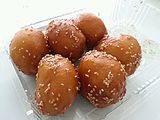 Tongyeong-kkulppang | |
| Alternative names | Honey bread |
|---|---|
| Type | Bread |
| Place of origin | South Korea |
| Region or state | Tongyeong, Jinju |
| Associated cuisine | Korean cuisine |
| Created by | Jeong Wonseok |
| Invented | 1963 |
| Main ingredients | Wheat flour dough, syrup, red bean paste |
| Variations |
|
| Korean name | |
| Hangul | 꿀빵 |
|---|---|
| Revised Romanization | kkulppang |
| McCune–Reischauer | kkulppang |
| IPA | [k͈ul.p͈aŋ] |
Kkulppang, ( Korean: 꿀빵) also known as honey bread, is a South Korean dish. It is a sticky, sweet bread filled with sweetened red bean paste. [1] Softer, fluffier ones that are made in Tongyeong, South Gyeongsang Province in South Korea, are called Tongyeong-kkulppang, being a local specialty. [2] In an adjacent city called Jinju, crunchier Jinju-kkulppang is sold as a local specialty. [3] Shortly after the Korean War, many bakeries in Tongyeong were sold. Fishermen and shipbuilding workers who worked on the beach simply ate a meal or snack because they could be kept for a long time despite the warm climate of Tongyeong. [4]
History
Kkulppang was first made and sold in 1963 by Jeong Won-seok (정원석) at a stand in front of his house in Hangnam-dong, Tongyeong. [5] In the early 1960s, when post- war impoverishment was severe, the bread was made with rationed wheat flour. [2]
Preparation
Sifted wheat flour is kneaded with eggs to form dough. [6] The dough is then rolled into small balls and filled with sweetened red bean paste, deep-fried in vegetable oil, and then coated with syrup and toasted sesame seeds. [6]
Varieties
Fillings for tongyeong-kkulppang other than the typical red bean paste include sweet potato, chestnut, yuja and green tea. [7]
Gallery
-
Tongyeong-kkulppang sold at a store
-
A pack of Tongyeong-kkulppang
-
Tongyeong-kkulppang filled with red bean paste
References
- ^ McGill, Bobby (26 March 2013). "Tongyeong: Meeting spring early in the "Naples of Korea"". Seoul Magazine. Retrieved 7 June 2017.
- ^ a b 양, 성빈; 조, 서연 (14 September 2012). "통영 꿀빵의 원조, 100년 역사의 기업으로 발돋움". Sisa magazine (in Korean). Retrieved 11 June 2015.
- ^ 원, 성윤 (13 November 2015). "'식당의 발견' (3) 덕인당 : 당신이 여태 먹어보지 못한 '꿀빵'의 바스락거림". The Huffington Post (in Korean). Archived from the original on 14 August 2017. Retrieved 7 June 2017.
- ^ "통영 꿀빵". 네이버 지식백과.
- ^ "오미사 꿀빵 소개". 오미사 꿀빵 (in Korean). Retrieved 7 June 2017.
- ^ a b "Kkulppang / Tongyeong" 꿀빵 / 통영. Local Information Portal (in Korean). Korea Local Promotion Foundation. Archived from the original on 12 November 2017. Retrieved 9 September 2015.
- ^ 이, 소원 (13 August 2015). "1년 365일 맛볼 수 있는 통영 사철 별미". Policy Briefing (in Korean). Ministry of Culture, Sports and Tourism. Retrieved 9 September 2015.


